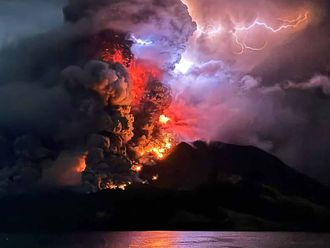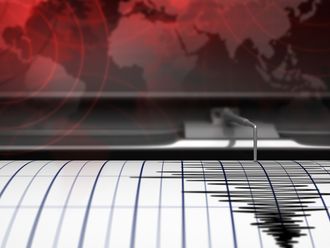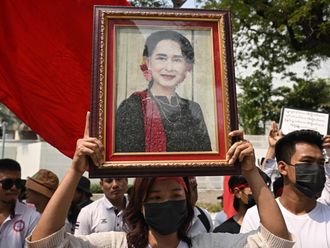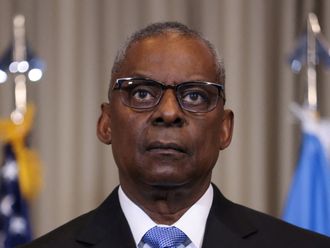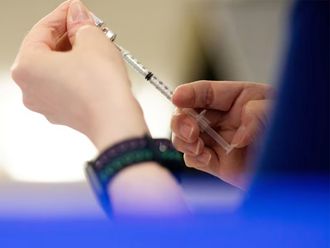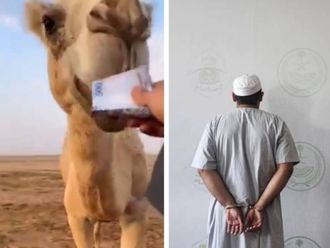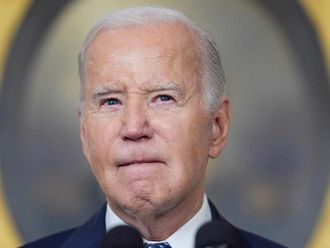SEOUL, South Korea: The two Koreas’ rare high-profile talks Tuesday took place at the jointly controlled area inside the world’s most heavily fortified border — the same place where North Korean soldiers recently sprayed bullets at a comrade who was making a daring dash for freedom.
The defecting soldier was hit five times, but he survived and is now recovering in South Korea. The dramatic video of his defection, released by the American-led UN command, showed again why the area, called Panmunjom, is known as one of the scariest places on Earth.
On Tuesday, Panmunjom captured international headlines again when a group of high-level North Korean officials walked across concrete slabs that make up a military demarcation line for their first formal talks with South Korea in more than two years.
A look at Panmunjom, whose mystique makes the place not only a potential flash point, but also a venue for talks and a tourist site:
No-man’s land
Panmunjom sits inside the 4km-wide Demilitarized Zone, a buffer zone created at the end of the 1950-53 Korean War. Once an obscure farming village, it was where the armistice that ended the Korean War was signed.
No civilians live there, and a cluster of blue huts form a Joint Security Area overseen by North Korea and the UN. Command.
The 248km-long DMZ is guarded on both sides by mines, razor-wire fences, tank traps and combat-ready troops. But Panmunjom is the only DMZ location where North and South Korean troops stand only several feet away from each other. North Korean soldiers wearing lapel pins with the portraits of late North Korean leaders use binoculars to monitor the South, while tall South Korean troops wearing aviator sunglasses stand motionless like statues.
This unique scene makes it a popular tourist spot, drawing curious visitors to both sides of the village.
Past bloodshed
The most notorious incident at Panmunjom happened in the summer of 1976, when two American army officers were killed by axe-wielding North Korean soldiers.
The US officers had been sent out to trim a 12-metre tree that obstructed the view from a checkpoint. The attack prompted Washington to fly nuclear-capable B-52 bombers toward the DMZ to intimidate North Korea. Then-North Korean leader Kim Il-sung, the late grandfather of current ruler Kim Jong-un, expressed regret over the incident before animosities eased.
In 1984, North Korean and UN. Command soldiers traded gunfire after a Soviet citizen defected by sprinting to the South Korean sector of the truce village. The incident left three North Korean soldiers and one South Korean soldier dead.
The rival Koreas have had similar violent confrontations along other parts of the DMZ in the past. No deadly clashes have occurred in recent years, but a 2015 landmine blast that maimed two South Korean soldiers pushed the Koreas to the brink of an armed conflict. South Korea blames North Korea for the explosion.
Venue for talks
Military officials from North Korea and the UN. Command used to meet at Panmunjom to oversee the armistice. In recent years, it has been used for occasional talks between the two Koreas.
Tuesday’s talks were being held at Peace House, a Seoul-run conference hall located in the southern half of the village. The facility has equipment that can feed real-time closed-circuit TV footage of the talks to South Korean leaders in Seoul. It also allows North Korean leaders in Pyongyang to listen to the talks, according to South Korean media.
North Korea operates another conference room, called ‘Panmungak’, on the northern side of Panmunjom.
Before Tuesdays’ meeting, the most recent high-profile gathering in Panmunjom was in August 2015, when negotiators for the rivals met for nearly 40 hours and reached a deal that allowed them to pull back from a military standoff triggered by the landmine explosion.
US Presidential visits
US presidents and other top officials have often travelled to Panmunjom and other areas of the DMZ at times of heightened tensions on the Korean Peninsula. They have peered through binoculars across the border and vowed to boost the US military alliance with South Korea.
In 1993, then-President Bill Clinton visited Panmunjom when the North Korean nuclear crisis first flared. In 2002, President George W. Bush visited the DMZ a few weeks after he labelled North Korea part of an “axis of evil”.
In 2012, ahead of a planned North Korean long-range rocket launch, President Barack Obama visited a front-line US military camp just south of the DMZ and told American troops they are protectors of “freedom’s frontier”. Obama’s trip came days after North Korean leader Kim Jong Un visited Panmunjom.
In November 2017, President Donald Trump planned to visit the DMZ to underscore his stance against North Korea’s nuclear programme when he came to South Korea as part of an Asian tour, but his plans were thwarted by heavy fog that prevented his helicopter from landing at the border area.


